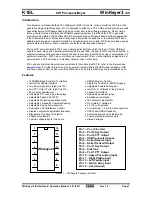
47
1
Operation and functional characteristics
Doors positioned in escape routes - Emergency exits - must be capable of being opened at any time without
outside aids. As a result, their locks must feature a panic function, i.e. when actuating the internal handle, the pre-
locked bolt must also open. On the other hand, the doors must remain locked for security reasons. This leads in
many instances in administrative buildings, department stores, industrial plants and similar properties to problems.
The relevant doors can no longer be effectively monitored.
In order to gain control over this situation without incurring unreasonable expense, systems are integrated which
electrically lock the doors, monitor their locked status and signal when they are opened or unlocked.
To allow opening in case of emergency this type of system - with only a few exceptions - is always equipped with
an emergency switch whose actuation immediately switches off the electrical lock, and so releases the door for
people to pass through and initiates an alarm.
The locking elements must hold the door shut with sufficient holding power and reliably unlock it in case of
emergency, even when it is subjected to a preload.
Furthermore, this type of system must also offer certain control functions to allow doors to be briefly or
continuously released should the circumstances so require.
In addition, it must also be possible for a fire alarm system, if available, to trigger emergency unlocking of the
door.
As a supplementary function, the effeff emergency exit control unit 720-30/32 features an evaluating unit for
effeff smoke detectors.
Generally, the emergency exit terminal 1337-10/11 or the terminal module 1370-10 is used as a control and
signalling device for the effeff emergency exit control unit. On a parallel basis, a 1332 control unit - for example as
an external operator terminal -and also a central control panel can be connected to the emergency exit control unit.
In exceptional cases, i.e. when release of the door(s) should take place only from a central location, the 1332
control unit can also be used directly at the door as a stand-alone switching and display element. However, then
special regulations must be observed and model 720-32 equipped with a special security relay circuit must be used
as a control unit.
Note!
The relevant statutory building regulations must be observed when installing and operating electrical
locks in escape routes.
Agreement of the units with the "Directive on locking systems for doors in escape routes (EltVTR 12/97)”
(Building register A part 1, no. 6.19) has been tested by TÜV Rheinland in Cologne.
Test Certificate no: R 2011393
















































